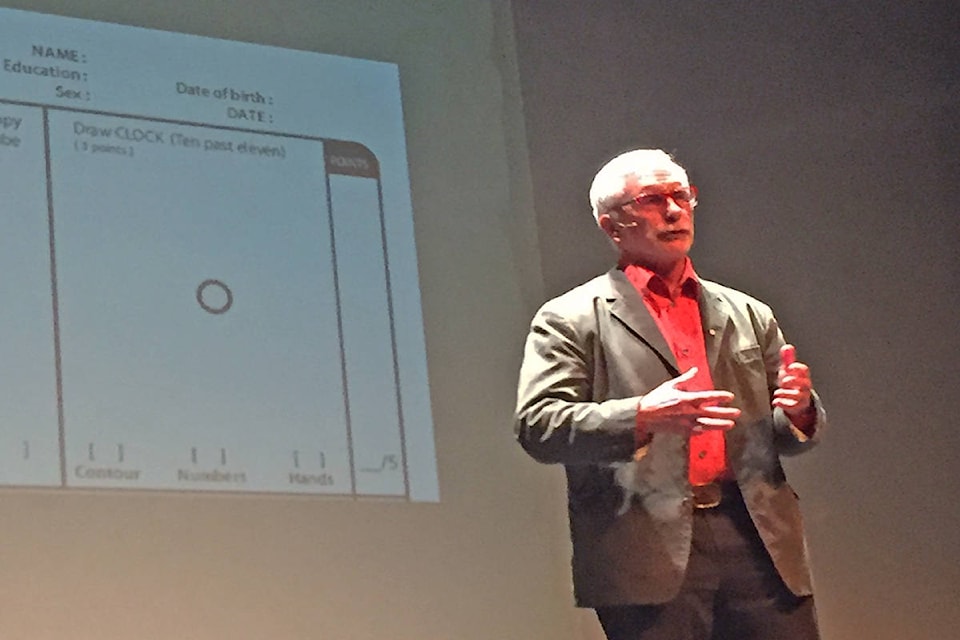Finding a cure for Alzheimer’s disease remains a fascinating and mysterious journey in which the stakes are incredibly high.
But with the testing required before drugs are approved as a treatment option, that isn’t likely to happen before 2025.
At the same time, the number of people diagnosed with Alzheimer’s has declined in terms of expectations.There are currently 850,000 cases of Alzheimer’s in Canada, and that was expected to double by 2030, but now that projection has reduced from 1.5 million to 1.2 million.
Those were some of the issues surrounding Alzheimer’s disease highlighted in a presentation by Canadian science writer and broadcaster Jay Ingram in a public forum held Tuesday night at the Kelowna Community Theatre.
The forum was one of several events being held throughout March to mark the 5th annual Okanagan Embrace Aging initiative, a collaboration of UBC Okanagan Healthy Living and Chronic Disease Prevention, Interior Savings Credit Union and Interior Health.
Ingram’s 45-minute presentation addressed the questions of can I get Alzheimer’s disease, how do I lessen the risk of getting it and if I get it what happens then. But he noted much of what we know about the disease often just creates more questions than answers.
Related: Okanagan business ‘meats’ need for Alzheimer’s support
On the treatment aspect, Ingram said the medical science research community is “behind the 8-ball” because since the disease was first identified by Dr. Alois Alzheimer in 1906 it was largely ignored in the medical community.
Alzheimer noticed changes in the brain tissue of a 51-year-old woman who had died from what was referred to as an unusual mental illness, exhibiting symptoms such as memory loss, language problems and unpredictable behaviour.
What Alzheimer discovered in 1906 was that the disease stemmed from the abnormal buildup of plaque obstructions between nerve cells in the brain.
“This case was considered an outlier occurrence because people who suffered from dementia like illness then tended to be in the 70 to 80 age range,” Ingram recalled.
That all changed in the 1970s because of three isolated events.
The first was a medical journal article written by a neurologist Robert Katzman, in which he called out the alert of Alzheimer’s disease as a potential giant killer.
“Katzman claimed Alzheimer’s was the fourth largest disease killer in the U.S. at a time when it wasn’t even considered in any such category,” Ingram explained.
That was followed by the case of actress Rita Hayworth, who lived in a New York City apartment building and other tenants were actively trying to get her evicted because she always appeared to be drunk.
Related: Brain health focus of Kelowna workshop
In reality, Rita Hayworth had Alzheimer’s disease, and when that diagnosis was made her celebrity status elevated discussion of the disease into the public discourse.
The third factor was syndicated newspaper columnist Dear Abby, who received a letter from someone signed ‘Confused’ talking about their Alzheimer’s symptoms and seeking help. The columnist published the letter in her column and referred the letter writer to the Alzheimer’s Society of New York City.
“That public referral generated 22,000 similar letters to the society’s office, and it was later revealed that ‘Confused’ was actually someone from the society who submitted the letter in the first place, so that was a case perhaps where the ends justified the means.
“Those three events galvanized public interest in Alzheimer’s disease, but it also illustrated the problem we face today, where no research to find a cure took place from 1902 until the 1970s.”
Ingram said while some progress has been made developing drugs that control the brain buildup of plaques, it has proven unsuccessful in curtailing onset of the disease, which has been baffling for researchers to figure out why.
Related: Bennett family helping educate about Alzheimer’s
“Where research is taking place now is with bio-markers to indicate the onset of the disease at an early stage, where the buildup of brain plaques can be detected in other less invasive ways such as testing the cerebral spinal cord fluid,” he said.
“But if that offers solutions, the question becomes to you give people drugs for Alzheimer’s disease who have no current symptoms, how do you identify those people through testing and ultimately how does that impact the growth of the disease. It raises some philosophical issues.”
He said familial genes are a leading factor for early on-set Alzheimer’s, but other health factors attributed to the disease at both early and late stages in life include less education, hearing loss, hypertension, obesity, smoking, depression, physical inactivity, social isolation and diabetes.
“Together all those factors add up to about 35 per cent increased chance of getting Alzheimer’s, so if you can control those things to a healthy level, that’s a pretty significant drop,” he said.
“There are many ways within our control to reduce the risk of getting Alzheimer’s and at this stage I think that is the message people need to take forward. There is still much we don’t know or understand about the disease because of the complexity of the brain.”
To report a typo, email: edit@kelownacapnews.com.
<>@BarryGerding
barry.gerding@blackpress.ca
Like us on Facebook and follow us on Twitter.
